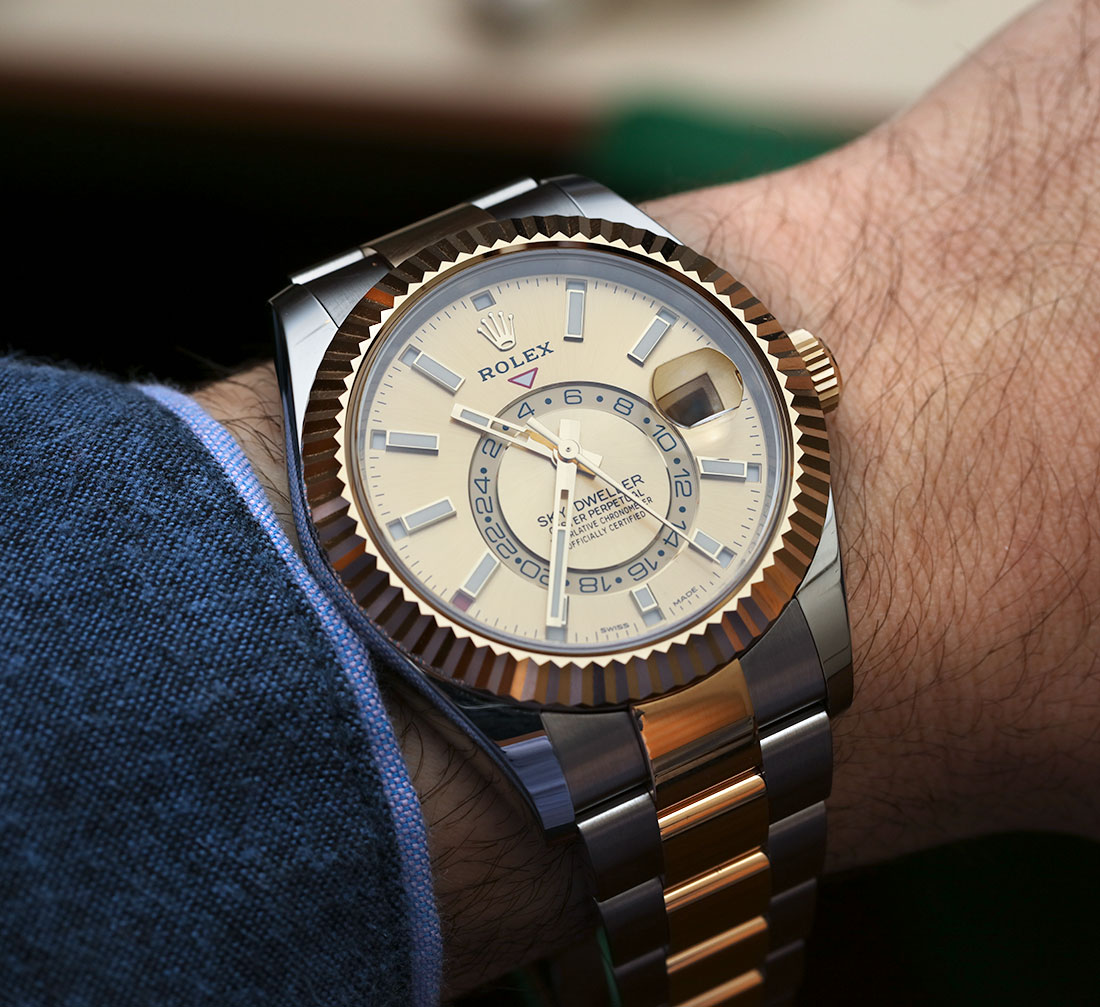
When Rolex initially debuted the Oyster Perpetual Sky-Dweller watch collection at Baselworld 2012, the watch world acted predictably. That reaction was the hesitation that comes from nothing new as presented to a community of ultra-conservatives. Yes, watch collectors tend to be ultra conservative, which is one of the reasons why Rolex as a brand continues to do so well. Buying a Rolex isn’t just buying a tool to tell the time. Buying a Rolex is not only buying into a particular club of Rolex owners, but is also about buying a “design institution.” Get a Submariner or Datejust and you are investing in a look which has been around for more than 60 years. Being able to know what you are getting and that the thing you are getting is already popular is one of the major benefits of getting a Rolex. So what happens when the most conservative watch brand out there offers up something new?
Mind you that today in 2018 the Rolex Sky-Dweller is hardly new but it is still the newest kid (more or less) on the Rolex block. I don’t know the instance prior to the Sky-Dweller launch that Rolex introduced a brand new collection name, but it seems to have been quite long ago. The Sky-Dweller introduced a brand new movement, which happens to be the most complicated movement that Rolex produces. This annual calendar GMT is their “grand complication” and is assembled by a dedicated team among the larger Rolex watchmaker staff. The movement is a beautiful thing in operation and concept, but we will get to that more later.

What also set the Sky-Dweller apart from most other Rolex watches was the size. Even though the case design continues to be the Rolex Oyster that we know and love, Rolex produced it in a 42mm wide case, making it the largest “dressy” timepiece produced by the brand. Also predictable at the time of release was that that Sky-Dweller would be very expensive. Rolex tends to debut new models and movements in all-gold cases, only to release the watch in a two-tone or all-steel variety later. As such, Rolex didn’t debut a Rolesor (steel and gold) version of the Sky-Dweller until 2017. There are no all-steel models because Rolex’s signature fluted bezel is made in gold. However, the most “accessible” version of the Sky-Dweller comes with an all-steel bracelet and case with just the bezel in 18k white gold. To put things in perspective the Sky-Dweller in 18k Everose gold on a matching bracelet currently costs $48,850 while the entry level price for the mostly steel model is $14,400. The reviewed reference 326933 is priced at $17,150 because of the added gold material in the bracelet and crown.

The purpose of the Sky-Dweller was to introduce a timepiece for the modern jet-setter who uses his watch both for utility and as a status item. Rolex listened to the desires of many people to produce a larger, everyday non-sports watch and also understood that something many of its customers have in common is travel. The in-house made caliber 9001 automatic movement offers the wearer a different GMT time read-out as compared to Rolex’s other GMT-hand equipped watches, and introduced one of the best annual calendar systems on the market. Annual calendars tend to be considered an ideal combination of complexity and practicality in the context of a mechanical calendar – especially when considering how today’s mechanical watch wearers rely on their watches and often wear multiple watches. Perpetual calendars are indeed more complex, but for many people they simply aren’t practical when you consider that today’s luxury watch lovers tend to wear more than one watch in rotation.

Rolex likes to brag about how many patents are in the caliber 9001 (seven of them). It is indeed a really complicated movement. As a company Rolex likes to actually focus on more simple movements because they tend to last longer and require less service. No doubt that the caliber 9001 is robust, and its complexity is actually shrouded by how simple it can be to use. Let’s start with the information on the dial. The most unique part of the Sky-Dweller as compared to other Rolex watches is the exposed eccentric ring on the dial used to display the GMT time. The second time zone is read under 12 o’clock via the red and white arrow pointer. This display was both novel and non-Rolex when it was launched and instantly sparked debate. In fact, so did the entire dial of the original Sky-Dweller watches that had either Arabic or Roman numeral hour markers in the various colors available. While many people appreciated the Sky-Dweller’s novelty when it first came out, few called it particularly pretty.

The size, price, and complexity made it the “beast” of Rolex watches. Eventually Rolex would redesign the Sky-Dweller dial, putting it more in line with the design of the Rolex Datejust 41 (aBlogtoWatch Review here). So much so that I feel the Datejust 41 and Sky-Dweller are like close siblings. You can even get the watches similarly-styled with the same three-link Oyster bracelet, white baton hour markers, Rolesor case, and champagne-colored dial. That could very well make it difficult for some people to decide between a Datejust 41 and a Sky-Dweller (even though there is a few thousand dollar price difference). Then again, it wouldn’t be the first time someone had a difficult decision about choosing just one of two seemingly similar Rolex watches.


What everyone loved about the Sky-Dweller when it first came out is still one of its best and most innovative features – that being the annual calendar display. Rolex’s goal was to keep the dial as clean and legible as possible – so adding yet another dial or window to indicate the month in addition to the date wasn’t ideal. More so, the month indicator isn’t something you tend to look at constantly, so having it in front of your face all the time doesn’t seem necessary. The result was using a place near the hour markers to indicate the current month. This is based on the idea that there are 12 hours as well as 12 months. When the window next to 1 o’clock on the dial goes from white to red, that means the current month is January. When the marker next to 2 o’clock is red, it is February, and so forth. Despite the logic of this simple system, people (not familiar with the watch) still need to be educated on what the dial is showing. I consider the Sky-Dweller to be a “stealth” annual calendar watch – and I’ve been very happy living with it.

